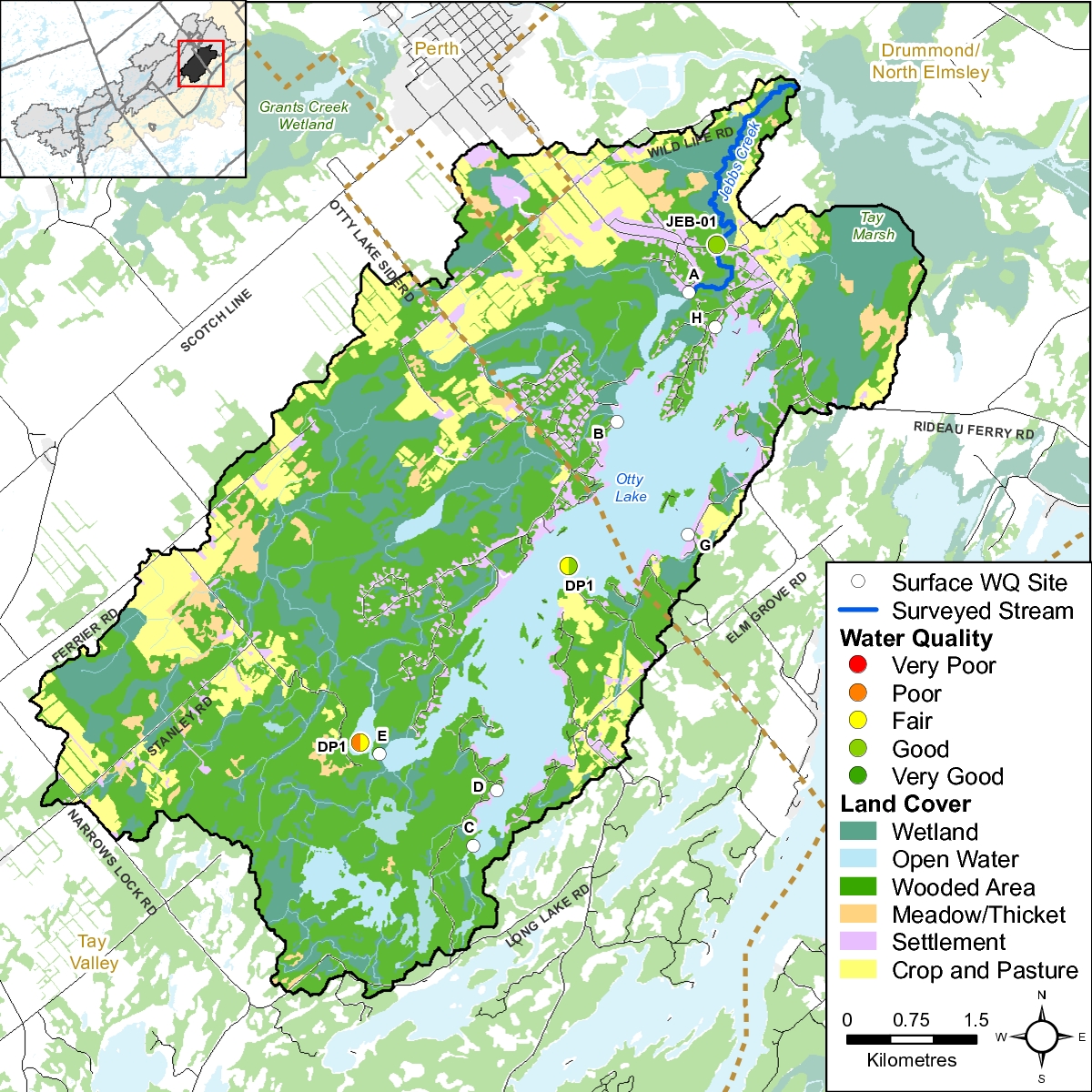2.0 Otty Lake Catchment: Water Quality Conditions
Surface water quality conditions in the Otty Lake catchment are monitored by the Rideau Valley Conservation Authority’s (RVCA) Watershed Watch Program and Baseline Water Quality Monitoring Program. Watershed Watch monitors watershed lakes to assess nutrient concentrations, water clarity, dissolved oxygen availability and pH. The baseline water quality program focuses on streams; data is collected for 22 parameters including nutrients (total phosphorus and total Kjeldahl nitrogen), Escherichia coli (E. coli), metals (like aluminium and copper) and additional chemical/physical parameters (such as alkalinity, chlorides, pH and total suspended solids). Figure 2 shows the locations of monitoring sites in the catchment.
Water Quality Rating in the Otty Lake Catchment
The water quality ratings across this catchment range from "Poor to Good" (Table 1); with a rating of "Poor to Fair in McLaren Lake; "Fair to Good" in Otty Lake and "Good" in Jebbs Creek as determined by the Canadian Council of Ministers of the Environment (CCME) Water Quality Index. "Poor" indicates that water quality is frequently threatened or impaired with conditions that often depart from natural or desirable levels. A "Fair" rating indicates that water quality is usually protected but is occasionally threatened or impaired; conditions sometimes depart from natural or desirable levels. A rating of "Good" indicates that only a minor degree of threat or impairment is observed and conditions rarely depart from natural or desirable levels. Each parameter is evaluated against established guidelines to determine water quality conditions. Those parameters that frequently exceed guidelines are presented below. Data has been analysed over the 2006-2017 period for general trends and conditions. Table 1 shows the overall rating for the monitored surface water quality sites within the catchment and Table 2 outlines the Water Quality Index (WQI) scores and their corresponding ratings.
| Site | Location | 2006-2008 | 2009-2011 | 2012-2014 | 2015-2017 |
|---|---|---|---|---|---|
| JEB-01 | Jebbs Creek at Rideau Ferry Rd. | Good (87) | Good (83) | Good (87) | Good (92) |
| DP1 | Otty Lake | Fair (77) | Good (88) | Good (88) | Fair (77) |
| DP1 | McLaren Lake | Poor (59) | Fair (72) | Poor (61) | Poor (50) |
| Rating | Index Score |
|---|---|
| Very Good (Excellent) | 95-100 |
| Good | 80-94 |
| Fair | 65-79 |
| Poor (Marginal) | 45-64 |
| Very Poor (Poor) | 0-44 |
2.1 Otty Lake Water Quality
Surface water quality conditions in Otty Lake have been monitored by RVCA’s Watershed Watch Program since 2002. Data from the deep point site (DP1) has been used to calculate the WQI rating for Otty Lake, which ranged from Fair to Good over the 2006-2017 period (Table 1). Moderate nutrient concentrations, good oxygen availability and clear water all influenced this rating. The following discussion explains how each of the monitored water quality parameters contributes to the lake’s water quality.
This report also considers data from eight additional shoreline sites that are monitored around the lake. These sites have not been included in the calculation of the CCME WQI rating, as they are not monitored with the same frequency as the deep point site. However, they do provide important information on water quality conditions in the near shore areas. For locations of shoreline sites (A-H) please see Figure 2. Additional resources also include the extensive data collected by the Otty Lake Association (OLA) and results from the Ontario Ministry of the Environment Lake Partner Program (LPP); the results from these programs have been incorporated in this discussion to support the results produced by RVCA.
2.1.1 Otty Lake Nutrients
Total phosphorus (TP) is used as a primary indicator of excessive nutrient loading and contributes to abundant aquatic vegetation growth and depleted dissolved oxygen levels. The Provincial Water Quality Objective (PWQO) is used as the TP Guideline and states that in lakes, concentrations greater than 0.020 mg/l indicate an excessive amount of TP within the water column. Concentrations below 0.010 mg/l are generally considered to be minimal and unlikely to have problems associated with nutrient loading.
Total Kjeldahl nitrogen (TKN) is used as a secondary indicator of nutrient loading. RVCA uses a guideline of 0.500 mg/l to assess TKN[1] within surface waters.
Nutrients at the Otty Lake Deep Point
TP and TKN sampling results collected by the RVCA are presented in Figures 3 to 6. Variability has occurred in the sampled TP concentrations at this site (Figure 3 and 4), however no significant trend[2] was observed in the 2006-2017 dataset. Eighty-nine percent of samples analysed for TP were less than the TP guideline and the average concentration was 0.013 mg/l (Table 3). TKN concentration also showed variability and similar to TP results no significant change was observed (Figures 5 and 6). Ninety-three percent of reported results were below the TKN guideline and the average TKN concentration was 0.411 mg/l (Table 3).
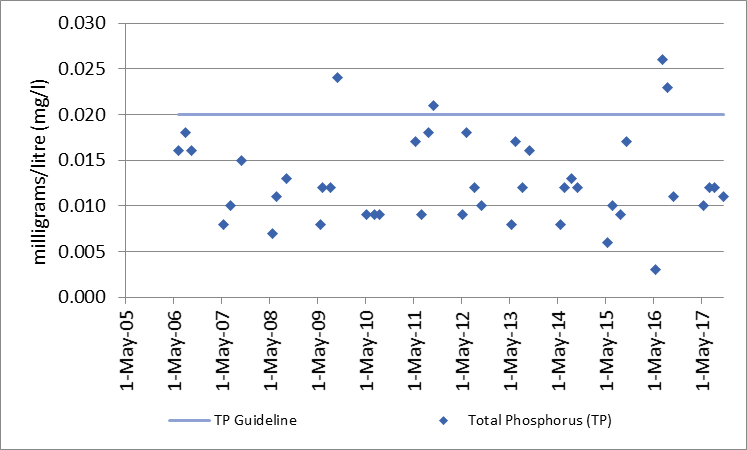
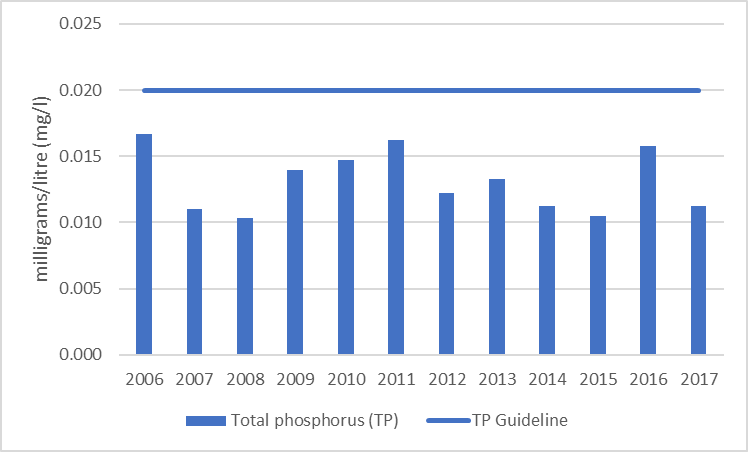
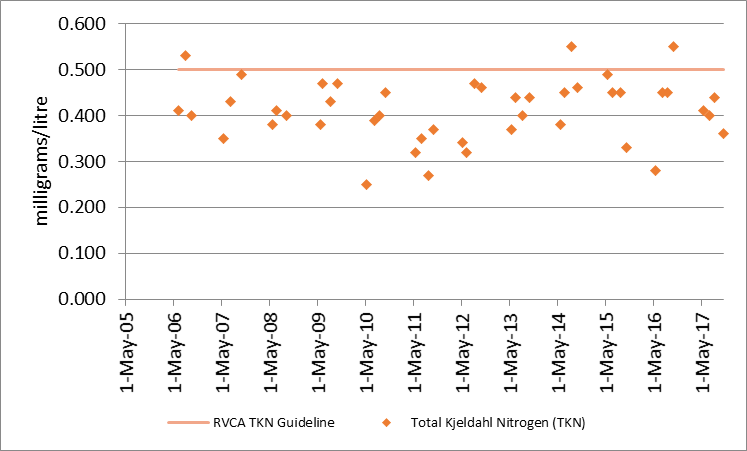
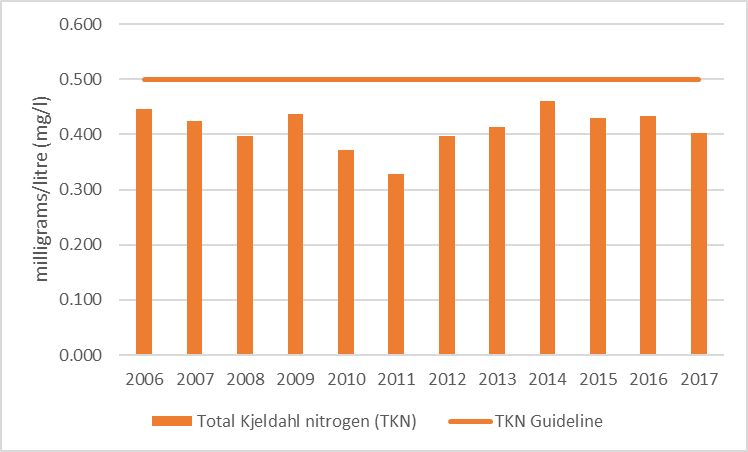
| Total Phosphorous 2006-2017 | ||||
|---|---|---|---|---|
| Site | Average (mg/l) | Below Guideline | No. Samples | Source |
| DP1 | 0.013 | 89% | 45 | RVCA |
| DP1 | 0.012 | 90% | 30 | OLA |
| DP1 | 0.013 | 98% | 130 | LPP |
| Total Kjeldahl Nitrogen 2006-2017 | ||||
| Site | Average (mg/l) | Below Guideline | No. Samples | Source |
| DP1 | 0.411 | 93% | 45 | RVCA |
| DP1 | 0.510 | 53% | 30 | OLA |
Table 3 also summarises nutrient data from the OLA and LPP monitoring programs. Please note that the OLA data set was only available from 2012-2017 and has fewer samples; also the LPP does not sample for TKN, therefore no data is available to compare results for that parameter. There was no significant difference found in the average TP concentration across the three monitoring programs; the same result was found when comparing the TKN results for RVCA and OLA[3] . Comparably to the RVCA data set, there was no indication of a change (trend) in the nutrient concentrations over the monitoring period in the OLA data set. The LPP TP data did show a slight decreasing trend in TP concentrations from 2006-2017. The increased number of samples (duplicates collected at the deep point) appear to have reduced the variability in this data set and perhaps made the trend more evident.
Overall, the data presented indicates that nutrient concentrations may be considered moderate with occasional instances of exceedances in the mid-lake, deep water site on Otty Lake.
Nutrients around Otty Lake
The average nutrient concentrations at monitored shoreline sites around the lake vary from year to year (Figures 7 and 8). Please note that in the 2006-2017 monitoring period sites A, B, C and E were sampled yearly; while sites D, F, G and H were only sampled in 2007, 2012 and 2017.
Average total phosphorous concentrations are below the TP guideline at the majority of sites; with the exception of site A, which typically shows exceedances (Figure 7). Site A is at the head of Marl Bay where Jebbs Creek narrows and is also the outflow of the lake; the cumulative flow through this portion of the lake dominated by wetland features may result in elevated nutrients at this site. No significant trend was noted in concentrations over the monitoring period.
Average TKN concentrations were also below the guideline at the majority of monitored sites; again, an exception to this is site A and E (Figure 8). Site E is located near the outflow of McLaren Lake which has had persistently elevated TKN levels due to the influence of wetlands that flow into that waterbody.
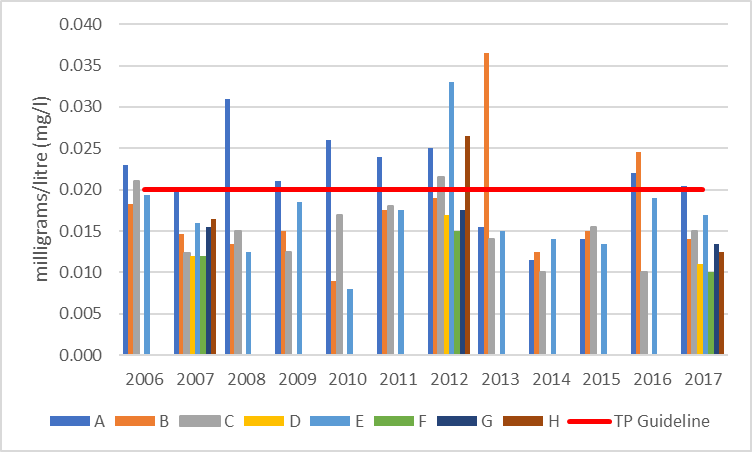
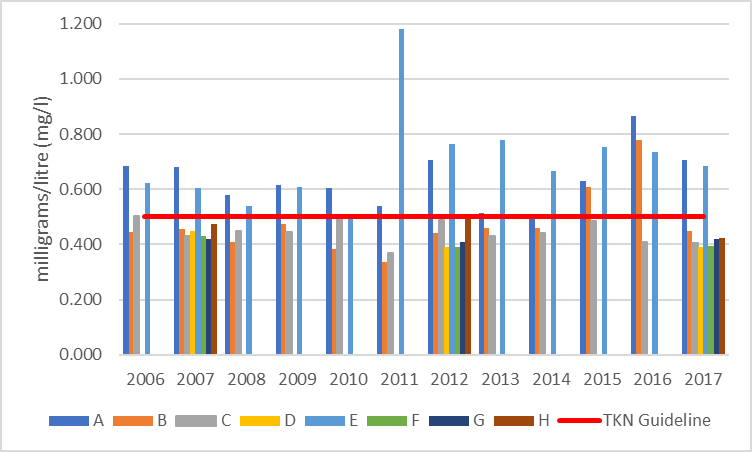
Summary of Otty Lake Nutrients
Otty Lake nutrient concentrations are generally below the guidelines, with few exceedances. It is possible that occasional problems with nutrient enrichment (i.e. algal blooms or excessive plant growth) may be observed in shallow, sheltered bays.
Efforts such as the diversion of runoff and enhanced shoreline buffers are important to continue to protect and enhance water quality, and reduce future nutrient increases. Nutrient exceedances may be partially attributed to the natural aging of a lake and basin characteristics. All residents can help minimise their impact on the lake by reducing nutrient inputs through practices such as proper maintenance of septic systems, keeping shorelines natural and using phosphate free soaps and detergents. Promotion of sound stewardship and protection around lake are important to maintain and protect water quality conditions into the future.
2.1.2 Otty Lake Water Clarity
Water clarity is measured using a Secchi disk during each deep point sample. Table 4 summarises the recorded depths with an average depth of 5.8 m and shows that all readings have exceeded the minimum PWQO of 2 m indicating that algae in the water column is not at excessive levels (good water clarity). Less than 2 m will indicate overproduction in a lake or significant inputs to the water column that are limiting light availability. Figure 9 shows that no individual reading has been below the guideline and measured depths range from 3.1 m to 9 m. A decreasing trend was observed within the 2006-2017 data set, indicating that Secchi depths have been reduced over this period. It should be noted that Secchi depths in many waterbodies have been influenced by the colonization of zebra mussels resulting in clearer waters than may have been seen prior to the introduction of this species; zebra mussels have been reported in Otty Lake since 2005. The declining trend may be attributed to the population dynamics of this species as minimal changes have been noted in other monitored parameters (i.e. nutrients, pH, dissolved oxygen conditions).
| Secchi depth 2006-2017 | |||
|---|---|---|---|
| Site | Average (mg/l) | Below Guideline | No. Samples |
| DP1 | 5.8 | 100% | 41 |
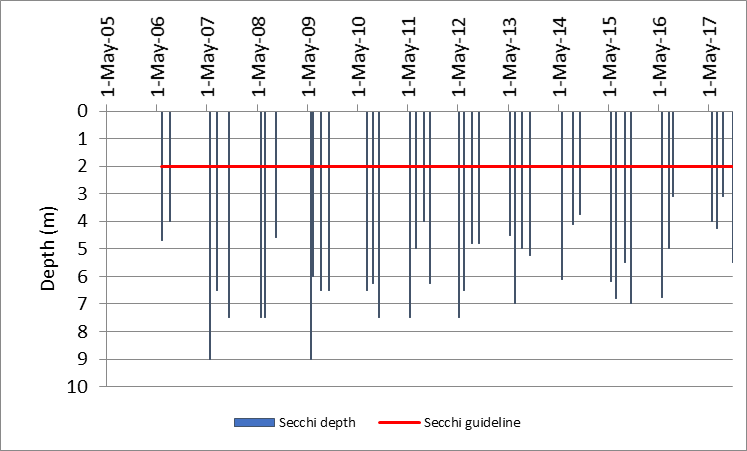
Summary of Otty Lake Water Clarity
Waters in Otty Lake are very clear and sufficient sunlight is able to penetrate the water column to support aquatic life and provide sufficient visibility for safe recreational use (boating, swimming).
2.1.3 Otty Lake Fish Habitat
Two other factors, dissolved oxygen/temperature and pH were also assessed to provide an overall sense of the health of Otty Lake from a fish habitat perspective.
2.1.3.1 Otty Lake Dissolved Oxygen and Temperature
The red bars in Figure 10 show the depths where suitable conditions exist for warm water fish species (temperature less than 25°C and dissolved oxygen greater than 4 mg/l) at the deep point site. The vertical axis represents the total lake depth at each site where the profile is taken. Suitable conditions typically decline throughout the summer to about 10 m of the water column, a very small portion of the water column met the requirements in the late summer of 2006 and 2016. Overall, no significant change was noted in conditions through the 2006-2017 period.
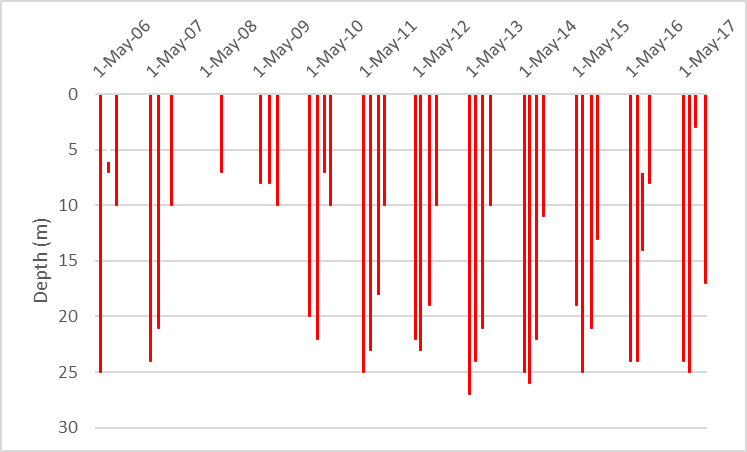
2.1.3.2 Otty Lake pH
pH is a basic water quality parameter used to assess the acidity of water, an important factor for aquatic life. Figure 11 shows monitored pH values over the 2006-2017 period.
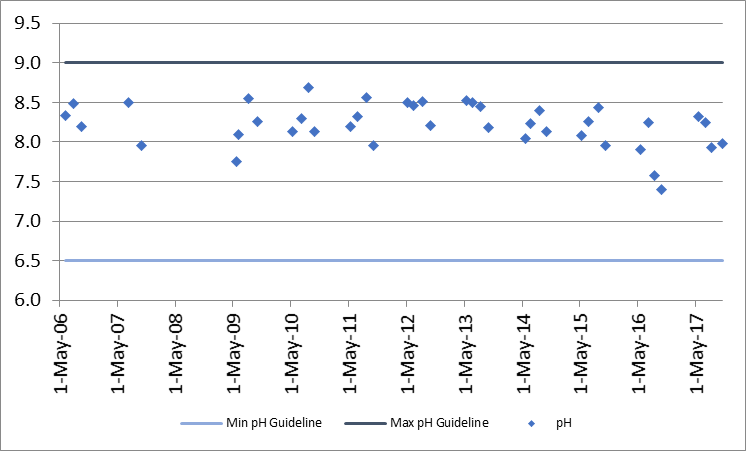
The majority of samples for the monitored period are within guidelines established by the Canadian Council of Minister's of the Environment which state that pH should be between 6.5 and 9 to protect aquatic life (Table 5). Surface water’s that are found to be more alkaline (higher pH) are common in many regions of the Tay River subwatershed and can generally be attributed to the geology rather than anthropogenic activities. Biological activities such as increased photosynthesis from algal blooms and plant growth may also influence pH.
| pH 2006-2017 | |||
|---|---|---|---|
| Site | Average (mg/l) | Within Guideline | No. Samples |
| DP1 | 8.22 | 100% | 41 |
Summary of Water Quality for Fish Habitat in Otty Lake
Overall the water chemistry data at the deep point describes suitable habitat conditions for fish species such as bass, walleye and pike. There is some evidence that the warming of the water column in the late summer/fall and limited oxygen availability at deeper depths may minimise the amount of habitat for some more sensitive species. pH conditions are within the end of the range recommended for the protection of aquatic life. Overall, the data indicates a healthy environment for aquatic species.
2.1.4 Otty Lake E. Coli
The RVCA samples for E. coli at their monitored shoreline sites twice each sampling season. E. coli data was not used in the calculations of the WQI rating for the lake due to differences in sampling frequency and site locations. E. coli data has been collected by both RVCA and OLA and is summarised in Table 6. The OLA samples for E. coli at 31 sites in Otty Lake, generally one to three times annually.
Throughout the 2006-2017 period 96 percent of samples collected by RVCA were below the E. coli guideline of 100 colony forming units (CFU) per 100 ml set by the PWQO; across the lake the count at the geometric mean [2] was 4 CFU/100ml (Table 6). The OLA E. coli data set also showed that the geometric mean of E. coli counts around the lake are minimal (2 CFU/100ml) with 99 percent of samples below the guideline (Table 6); providing further support for little indication of bacterial contamination around the lake.
| E. coli 2006-2017 | ||||
|---|---|---|---|---|
| Site | Geometric mean (CFU/100ml) | Below Guideline | No. Samples | Source |
| Otty Lake | 4 | 96% | 122 | RVCA |
| Otty Lake | 2 | 99% | 324 | OLA |
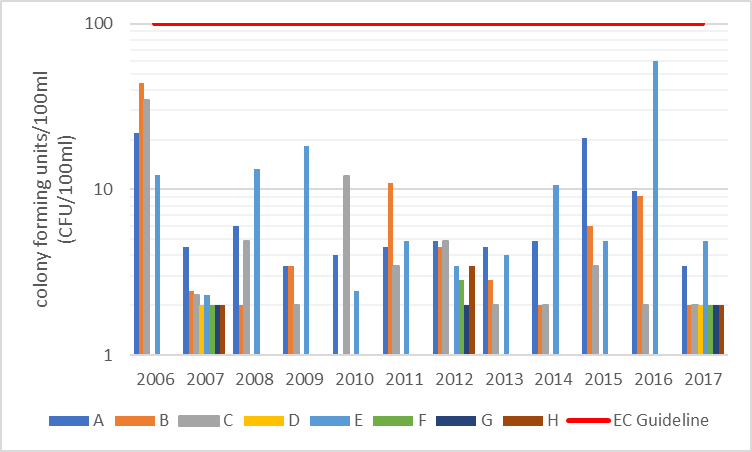
Figure 12 shows the distribution of counts across all RVCA shoreline sites. Site E, generally has higher results than other sites, but is not consistently elevated and should not be a cause for concern. All sites fell well below the guideline of 100 CFU/100ml.
Summary of Otty Lake Bacterial Contamination
The results presented above indicate that bacterial contamination is not a significant concern in Otty Lake and the water should be safe for recreational use such as swimming and boating.
2.2 McLaren Lake Water Quality
Surface water quality conditions in McLaren Lake have been monitored by RVCA’s Watershed Watch Program since 2006. Data from the deep point site (DP1) has been used to calculate the WQI rating which ranged from "Poor-Fair" in the 2006-2017 period (Table 1). Moderate to elevated nutrient concentrations and periods of limited oxygen availability influenced this rating. The following discussion explains how each of the monitored water quality parameters contributes to the lake’s water quality.
2.2.1 McLaren Lake Nutrients
Total phosphorus (TP) is used as a primary indicator of excessive nutrient loading and contributes to abundant aquatic vegetation growth and depleted dissolved oxygen levels. The Provincial Water Quality Objective (PWQO) is used as the TP Guideline and states that in lakes, concentrations greater than 0.020 mg/l indicate an excessive amount of TP within the water column. Concentrations below 0.010 mg/l are generally considered to be minimal and unlikely to have problems associated with nutrient loading.
Total Kjeldahl nitrogen (TKN) is used as a secondary indicator of nutrient loading. RVCA uses a guideline of 0.500 mg/l to assess TKN[1] within surface waters.
Nutrients at the McLaren Lake Deep Point
TP and TKN sampling results are presented in Figures 13 to 16. Variability has occurred in the sampled TP concentrations at this site (Figure 13 and 14), however no significant trend was observed in the 2006-2017 dataset. Seventy-two percent of samples analyzed for TP were less than the TP guideline and the average concentration was 0.017 mg/l (Table 3).[5] TKN concentrations were also variable over the monitoring period; as with TP results no significant change was observed (Figures 15 and 16). Most sample results exceeded the guideline (only 13 percent were below 0.500 mg/l) and the average TKN concentration was elevated at 0.636 mg/l (Table 3).
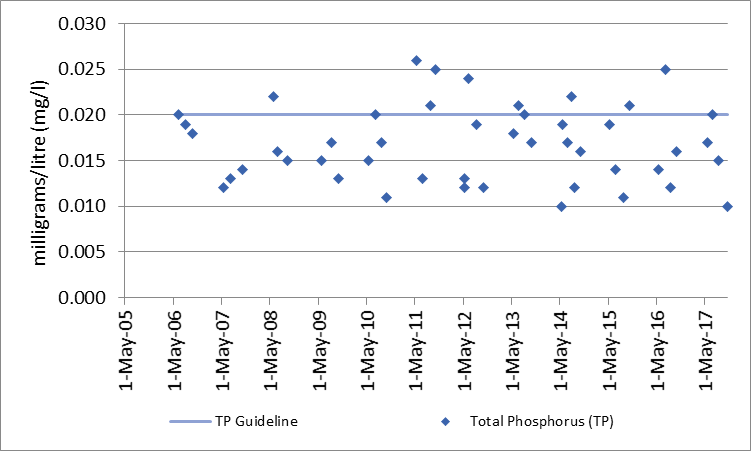
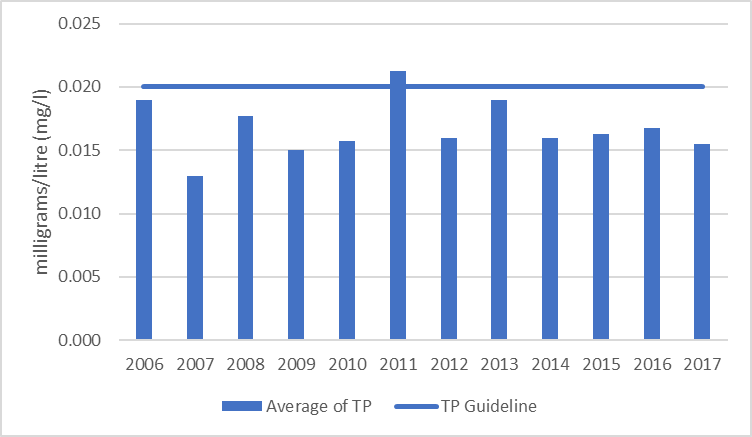
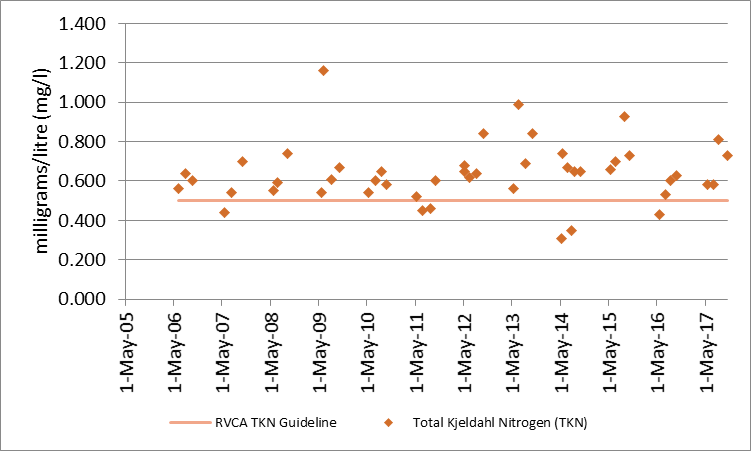
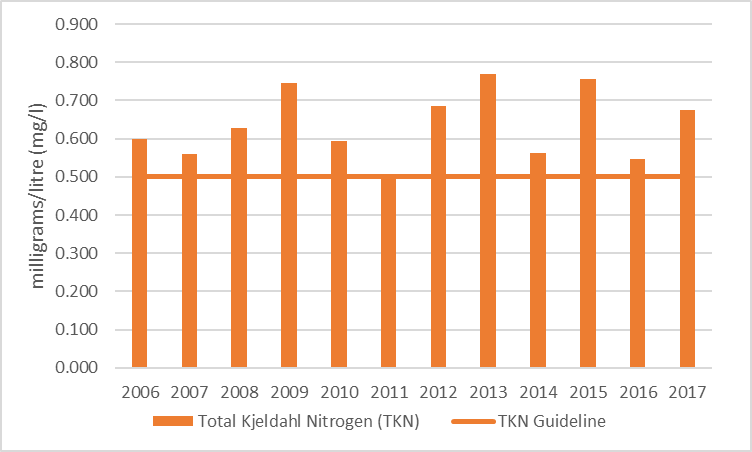
| Total Phosphorous 2006-2017 | |||
|---|---|---|---|
| Site | Average (mg/l) | Below Guideline | No. Samples |
| DP1 | 0.017 | 72% | 48 |
| Total Kjeldahl Nitrogen 2006-2017 | |||
| Site | Average (mg/l) | Below Guideline | No. Samples |
| DP1 | 0.636 | 13% | 48 |
Summary of McLaren Lake Nutrients
Overall, the data presented indicates that nutrient concentrations may be considered to range from moderate to elevated with regard to nitrogen. This can be attributed to the wetland area that drains into McLaren Lake; wetlands hold high levels of nutrients in their soils which may be flushed into the lake during periods of higher flows. Though development around the lake is fairly minimal, efforts by property owners such as the diversion of runoff and enhanced shoreline buffers are important to continue to protect and enhance water quality and reduce future nutrient increases. All residents can help minimise their impact on the lake by reducing nutrient inputs through practices such as proper maintenance of septic systems, keeping shorelines natural and using phosphate free soaps and detergents.
2.2.2 McLaren Lake Water Clarity
Water clarity is measured using a Secchi disk during each deep point sample. Table 8 summarises the recorded depths with an average depth of 3.09 and shows that the majority (98 percent) of readings have exceeded the minimum PWQO of 2 m indicating that algae in the water column is not at excessive levels (good water clarity). Less than 2 m will indicate overproduction in a lake or significant inputs to the water column that are limiting light availability. Figure 17 shows recorded readings relative to the guideline; measured depths range from 1.78 m to 5 m. As with Otty Lake, a decreasing trend was observed within the 2006-2017 data set, indicating that reduced Secchi depths are becoming more common. It should be noted that Secchi depths in many waterbodies have been influenced by the colonization of zebra mussels resulting in clearer waters than may have been seen prior to the introduction of this species; zebra mussels were first reported in McLaren Lake in 2006. The declining trend may be attributed to the population dynamics of this species as no other changes have been noted in other monitored parameters (i.e. nutrients, pH, dissolved oxygen conditions).
| Secchi 2006-2017 | |||
|---|---|---|---|
| Site | Average (m) | Below Guideline | No. Samples |
| DP1 | 3.09 | 98% | 43 |
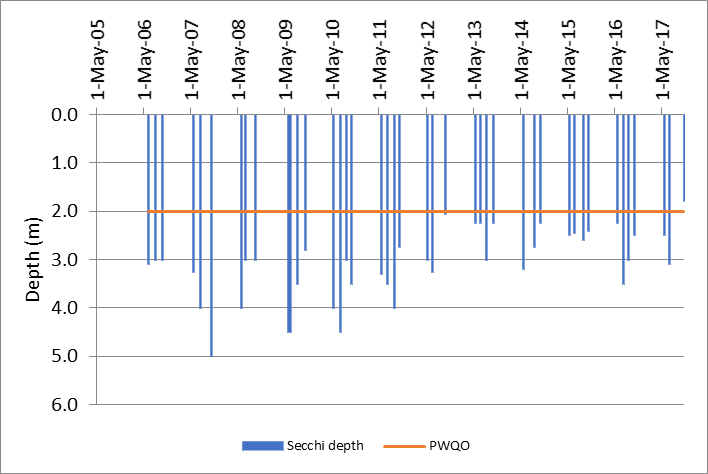
Summary of McLaren Lake Water Clarity
Waters in McLaren Lake are clear and sufficient sunlight is able to penetrate the water column to support aquatic life and provide sufficient visibility for safe recreational use (boating, swimming).
2.2.3 McLaren Lake Fish Habitat
Two other factors, dissolved oxygen/temperature and pH were also assessed to provide an overall sense of the health of McLaren Lake from a fish habitat perspective.
2.2.3.1 McLaren Lake Dissolved Oxygen and Temperature
The red bars in Figures 18 show the depths where suitable conditions exist for warm water fish species (temperature less than 25°C and dissolved oxygen greater than 4 mg/l) at the monitored deep point site. The vertical axis represents the total lake depth at the site where the profile is taken. Suitable conditions typically decline throughout the summer to about 4 m in the water column; this is generally due to very low oxygen availability below this depth. Overall, no significant change was noted in conditions between the 2006-2017 period.
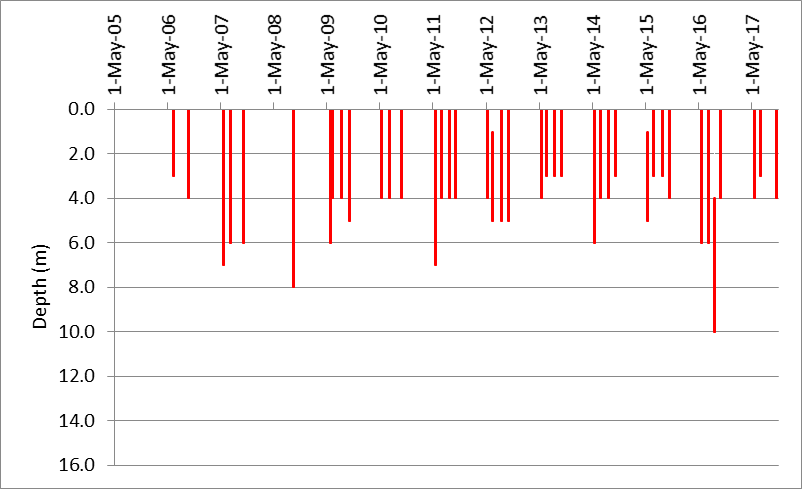
2.2.3.2 McLaren Lake pH
pH is a basic water quality parameter used to assess the acidity of water, an important factor for aquatic life. Figure 19 shows monitored pH values over the 2006-2017 period.
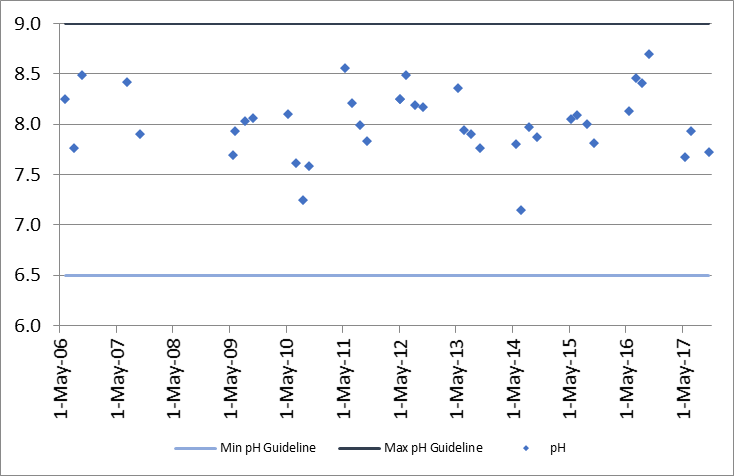
All results were within the guideline established by the Canadian Council of Minister's of the Environment which state that pH should be between 6.5 and 9 to protect aquatic life (Table 9).
| pH 2006-2017 | |||
|---|---|---|---|
| Site | Average (mg/l) | Within Guideline | No. Samples |
| DP1 | 8.02 | 100% | 41 |
Summary of Water Quality in McLaren Lake for Fish Habitat
Overall the water chemistry data at the deep point describes suitable habitat conditions for warm water fish species. The limited oxygen availability at deeper depths may limit the success of some sensitive fish populations or aquatic species. pH conditions are within the end of the range recommended for the protection of aquatic life.
2.3 Jebbs Creek Water Quality
There is one stream site on Jebbs Creek monitored in the Otty Lake catchment (JEB-01, Figure 2). Analysis of the data is based on samples collected from 2006 to 2017. Water quality at this site is reported as “Good” (Table 1) as determined by the Canadian Council of Ministers of the Environment Water Quality Index (CCME WQI). The score at this due to the majority of monitored parameters having results below established guidelines. For more information on the CCME WQI, please see the Tay River Subwatershed Report. Only those parameters with exceedances that influenced the rating will be discussed in the following sections.
2.3.1 Jebbs Creek Nutrients
Total phosphorus (TP) is used as a primary indicator of excessive nutrient loading and may contribute to abundant aquatic vegetation growth and depleted dissolved oxygen levels. The Provincial Water Quality Objective (PWQO) is used as the TP Guideline and states that in streams concentrations greater than 0.030 mg/l indicate an excessive amount of TP.
Total Kjeldahl nitrogen (TKN) is used as a secondary indicator of nutrient loading. RVCA uses a guideline of 0.500 mg/l to assess TKN [1] within surface waters.
Tables 10 and 11 summarise average nutrient concentrations at the monitored site on Jebbs Creek and show the proportion of results that meet the guidelines.
| Total Phosphorus 2006-2017 | |||
|---|---|---|---|
| Site | Average (mg/l) | Below Guideline | No. Samples |
| JEB-01 | 0.022 | 90% | 70 |
| Total Kjeldahl Nitrogen 2006-2017 | |||
|---|---|---|---|
| Site | Average (mg/l) | Below Guideline | No. Samples |
| JEB-01 | 0.633 | 29% | 70 |
The majority of TP results (90 percent) were below the guideline with an average concentration of 0.022 mg/l (Table 10). There is not much seasonal variability observed at the site apart from elevated results observed in September (Figure 20). There was one result of 0.150 mg/l collected in September of 2011 that was significantly elevated and should not be considered representative of conditions (Figure 21). Please note that no samples are collected over the winter months. Overall there was no significant trend in the monitoring data throughout the 2006-2017 period (Figure 21).
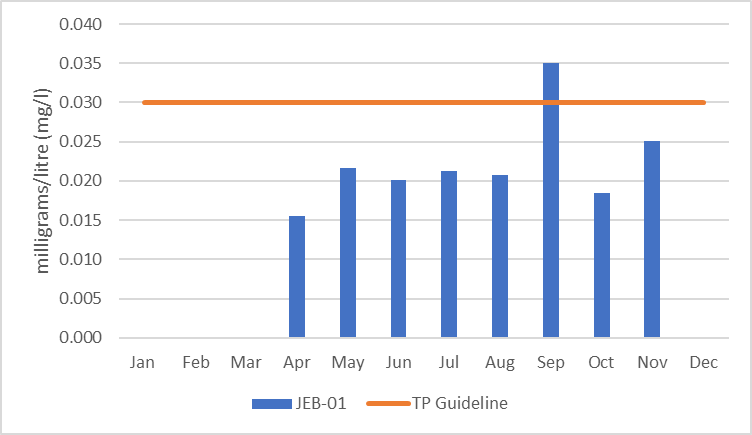
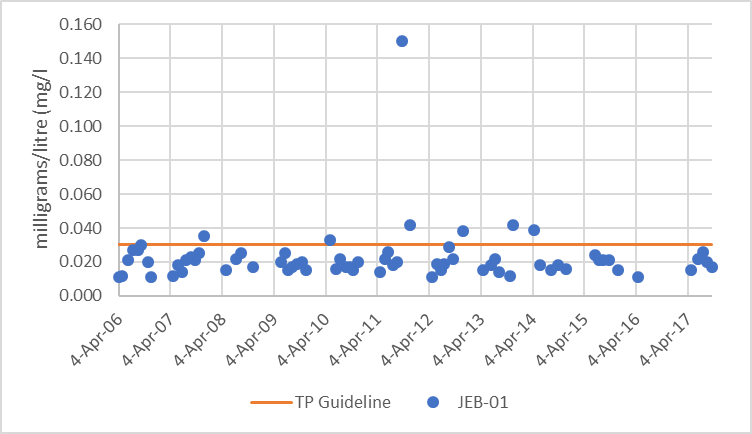
TKN results show that the bulk of results exceeded the guideline (Figure 23); 29 percent of samples were below the guideline and the average concentration was elevated at 0.633 mg/l (Table 11). TKN concentrations appear to increase throughout the summer months (Figure 22). However, as with TP results, a single elevated sample in September of 2011 is influencing the monthly average concentration (Figures 22 & 23). Overall there was no significant trend in the monitoring data throughout the 2006-2017 period (Figure 23).
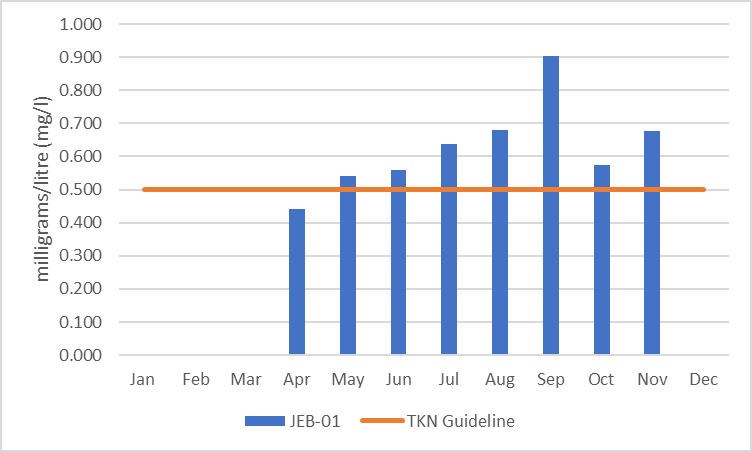
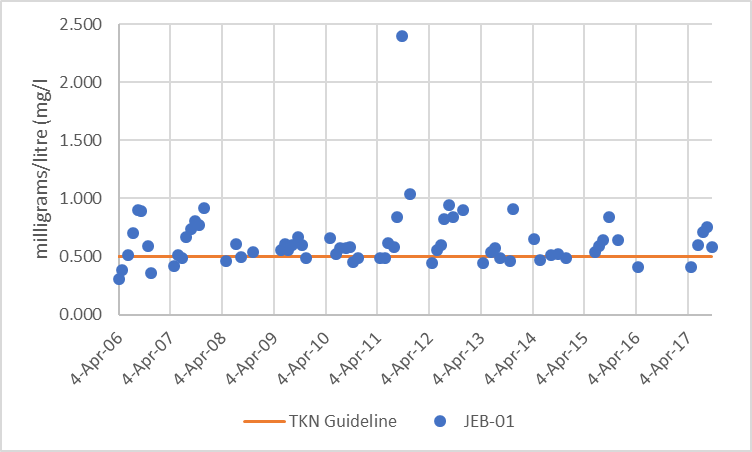
Summary of Jebbs Creek Nutrients
The data shows that nutrient enrichment is a feature of Jebbs Creek with regards to TKN. This is likely due to the influence of surrounding wetland areas. Wetlands are naturally rich in nitrogen and appear to be contributing to the concentrations in this creek. Though this is likely to be a natural condition it is important to reduce human impacts wherever possible. Strategies to reduce nutrient inputs may include diversion of runoff to the creek from surrounding developed areas (i.e. residences and roadways) and enhanced shoreline buffers.
2.3.2 Jebbs Creek E. Coli
E. coli is used as an indicator of bacterial pollution from human or animal waste; in elevated concentrations it can pose a risk to human health. The PWQO of 100 colony forming units/100 milliliters (CFU/100 ml) is used to assess E. coli. Counts greater than this guideline indicate that bacterial contamination may be a problem within a waterbody.
Table 12 summarises the geometric mean[4] for the monitored site on Jebbs Creek and shows the proportion of samples that meet the E. coli guideline of 100 CFU/100 ml. The monthly geometric mean with respect to the guideline for the 2006-2017 period is shown in Figure 24 and distribution of sampled counts is shown in Figure 25.
| E. coli 2006-2017 | |||
|---|---|---|---|
| Site | Geometric Mean (CFU/100ml) | Below Guideline | No. Samples |
| JEB-01 | 34 | 81% | 70 |
E. coli results at site JEB-01 indicate bacterial counts are typically below (81 percent) the E. coli guideline, similarly the count at geometric mean is 34 CFU/100ml (Table 12). E. coli counts are typically highest during the summer months as warmer temperatures are needed for bacteria to survive (Figure 24). Results have varied for each sampled year, but no trend was observed across the 2006-2017 period (Figure 25).
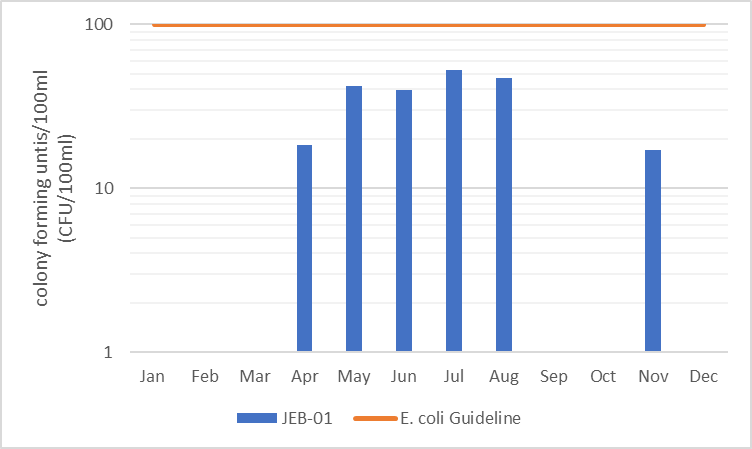
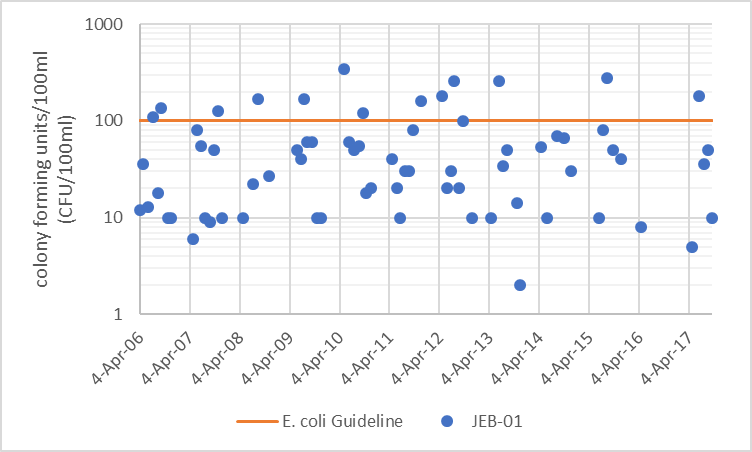
Summary of Jebbs Creek Bacterial Contamination
Results indicate that bacterial contamination is not a concern in Jebbs Creek. The count at the geometric mean is below the PWQO for both monitoring periods and a limited number of counts exceeding the guideline have been observed. The elevated samples that do occur are most likely due to wildlife and can be considered natural variability in the aquatic ecosystem. However, good stewardship practices should be maintained throughout the drainage area to protect both Jebbs Creek and the Tay River downstream; this includes properly maintaining septic systems, enhancing shoreline buffers and restricting livestock access; all are actions that can help to protect water quality conditions in Jebbs Creek.
[1] No Ontario guideline for TKN is presently available; however, waters not influenced by excessive organic inputs typically range from 0.100 to 0.500 mg/l, Environment Canada (1979) Water Quality Sourcebook, A Guide to Water Quality Parameters, Inland Waters Directorate, Water Quality Branch, Ottawa, Canada.
[2] Trends in the data were assessed using the Mann-Kendall trend test and Sens slope statistic.
[3] Comparisons of means was done using the two sample t-test, variances were assessed using the F test. Permutation tests of difference in means and the Wilcoxon Rank Sum on differences in medians was also used to evaluate the data sets.
[4] A type of mean or average, which indicates the central tendency or typical value of a set of numbers by using the product of their values (as opposed to the arithmetic mean which uses their sum). It is often used to summarise a variable that varies over several orders of magnitude, such as E. coli counts.
[5] One result from June 8, 2009 of 0.091 mg/l has been removed from the dataset, as this result differs significantly from the dataset. It is likely an outlier and may have been influenced by a contaminated sample, sample error or analytical error.
